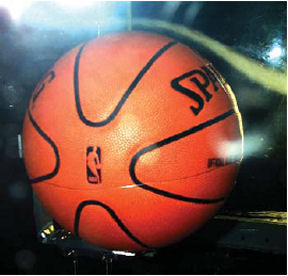Dribble Quibble: Experiments find that new basketball gets slick
A dispute in professional basketball about a new ball has bounced its way into a physics lab. A study launched last month at the University of Texas at Arlington compares a controversial plastic ball introduced in preseason games this summer by the National Basketball Association (NBA) with the previous standard—a leather-covered ball. The official basketball season, the first in which the new ball will be used, began this week.

So far, the Texas experiments indicate that the new ball bounces less elastically, veers more when it bounces, and becomes more slippery when damp than does the official leather ball of the past 35 years.
Many NBA players have griped about the new ball since teams began using it.
“The most significant finding is the slickness of the ball,” says University of Texas physicist James L. Horwitz. He, physicist Kaushik De, and their colleagues gauged friction for both new and old balls by sliding each along sheets of silicon. That material’s coefficient of friction is approximately that of the human palm, the scientists say.
The plastic balls, when dry, resisted sliding much more strongly than their leather counterparts did. Yet a single drop of a commercial eyewash, chosen to simulate sweat, slashed the plastic ball’s coefficient of friction by 55 percent, the scientists claim. In contrast, leather balls gradually increased their friction coefficients when wetted—to a maximum of about 130 percent of the figure for a dry leather ball.
“When the balls are dry, the synthetic ball is easier to grip, and when they’re wet, the leather one is much easier to grip,” Horwitz says. The scientists also found that leather balls absorb moisture about eight times as fast as the plastic balls do.
Spalding, the Springfield, Mass., manufacturer of both the new and old balls, claims that its tests throughout the design process produced different results. “The new composite [plastic] balls’ coefficient of friction outperformed the leather balls’ coefficient of friction in both wet and dry conditions,” says mechanical engineer Ron Laliberty, Spalding’s director of new-product development.
John J. Fontanella, a former college basketball player and now a physicist at the United States Naval Academy in Annapolis, Md., calls the Texas work “impressive.”
“The NBA should stick with the leather basketball for another year,” he advises. That would give the manufacturer time to develop a better plastic cover material. A new book by Fontanella on basketball physics comes out this month.
The Texas researchers are doing their study—for free—at the behest of Mark Cuban, owner of the Dallas Mavericks, an NBA team. He posted the preliminary test results online on Oct. 27 (http://www.blogmaverick.com/2006/10/27/nba-balls/).
In response to the findings, Cuban says that remedial steps are needed. These include frequent ball changes during games and perhaps a redesign of the cover once the current season ends.







